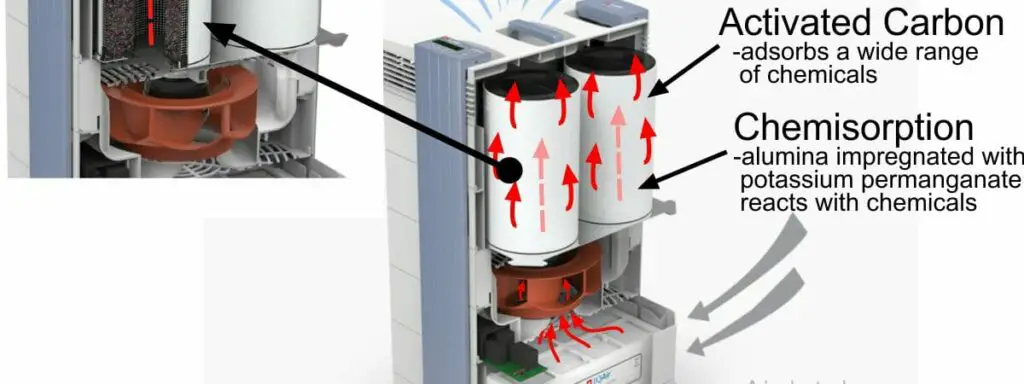We are all becoming more aware of chemicals in our environment and the health effects. Volatile organic chemicals (VOCs) are used in home construction and in many of the products that we use every day. VOCs and health is a complicated issue but in this article I give a simple and practical approach. I deal with the sources of VOCs in our home, the health effects, a practical way of measuring the levels in your home and measures that will keep VOC levels as low as possible. I intend that by the end of the article you will be able to assess the issue in your home and deal with it.
VOCs are universally present in indoor spaces. Even at low levels, they damage DNA and are linked to cancer. Measurement of levels is important. Ventilation as well as using an air purifier with a chemical filter, “off-gasing”, and avoiding products that emit VOCs all reduce levels in the home.
Organic compounds are compounds of carbon. They are volatile if they can form a gas at normal atmospheric indoor temperature and pressure. We now spend 90% of our time inside buildings, and the levels of volatile organic compound (VOC) in indoor air is 2 to 5 times those in the outdoor air. They are divided into very volatile organic compounds, volatile organic compounds and semi volatile organic compounds-
| Type | Boiling Point (oC) | Examples |
|---|---|---|
| Very volatile (gaseous) organic compounds | <0 to 75 | Propane, butane, methyl chloride |
| Volatile organic compounds | 75 to 250 | Formaldehyde, d-Limonene, toluene, acetone, ethanol (ethyl alcohol) 2-propanol (isopropyl alcohol), hexanal |
| Semi volatile organic compounds | 250 to 400 | Pesticides (DDT, chlordane, plasticizers (phthalates), fire retardants (PCBs, PBB)) |
Sources of VOCs
Indoor
There are multiple sources of indoor VOCs in our homes-
- Building products-glues, wood products, paint, insulating materials
- Cosmetics
- Clothing-leather permanent press fabric
- Cleaning products
- Burning organic material-tobacco smoke, wood
So we can alter this indoor air pollution by what we do in which products we use. For instance by using paint with a low VOC content.
Outdoor
VOC concentration is usually much lower in the external air and so there is a lower health risk. However there are some notable exceptions such as during forest fires. There are also some very industrialized areas where there can be a high concentration of VOCs in the external air, a notable example of this is “Chemical Alley” in the US.
Motor vehicles which burn organic fuels such as gasoline or diesel also produce VOCs, this may be a significant source in some areas.
VOCs and Health
How do VOCs Cause Health Effects?-DNA damage
One study compared female nail technicians exposed to VOCs with 152 healthy female volunteers. There was a correlation between VOC level and markers of oxidative stress as well as DNA damage.
In a study of asthmatic children there was a correlation between the levels of VOC metabolites in the body and the level of a metabolite in the urine which indicated DNA damage.
In an experiment with fruit flies the genetic effect of a mixture of volatile organic compounds were investigated. Trace levels of VOCs were shown to be associated with DNA damage.
Car spraying technicians were assessed for VOC exposure and DNA damage. The concentrations of benzene, toluene, ethylbenzene, xylenes and styrene in the workplaces were higher than those of controls. DNA damage was found to be higher in car sprayers than controls.
This diagram summarises the human health effects of VOCs-

Asthma
A review of 278 studies in 2015 found that approximately half showed a relationship between at least one VOC and asthma but that almost half showed no evidence of an effect. So the evidence regarding asthma and allergy is not high-quality and is inconsistent. However, a study from 2021 with more recent data and a better controlled trial found strong evidence to suggest that VOCs were associated with increased asthma symptoms. There was no exposure documented as causing asthma to develop, simply an exacerbation of existing symptoms.
Cancer-mainly nasopharyngeal carcinoma, leukemia and lymphoma
VOCs have been associated with particularly nasopharyngeal cancer, lymphoma and leukemia. The VOCs that have been linked to these are found in a variety of situations-
Cigarette smoke
Although particles are the usual pollutants that cause health effects, smoke is particularly damaging as it contains a significant concentration of chemicals. These are known as “gas-phase hazardous air pollutants” (HAPs).
Cigarette smoke is famous for its ability to cause lung cancer. It contains 6000 different chemicals 60 of which are known to cause cancer.
According to the American Cancer Society cigarette smoke contains-
- Nicotene
- Hydrogen cyanide
- Formaldehyde
- Lead
- Arsenic
- Ammonia
- Radioactive elements
- Benzene
- Carbon monoxide
- Tobacco specific nitrosamines
- Polycyclic aromatic hydrocarbons
Many of the compounds in the list above can cause cancer. However they can also cause heart disease and lung disease.

Wildfire smoke
The main chemicals in wildfire smoke are-
- Acrolein
- Formaldehyde
- Benzene
- Hydrogen cyanide
Most of these chemicals have been linked to cancer.
re are some very hazardous chemicals in both types of smoke and so we are going to need to choose our air purifier not only for its particle removing capability, but also on the basis of its ability to remove chemicals from the air.
Moth Repellant and Deodorant
Naphthalene is used in pest repellent in deodorant but is also found in cigarette smoke and vehicle emissions. Moth repellent is the most common cause of excessive concentrations of naphthalene. In a study from Michigan naphthalene caused an increase in cancer risk by approximately one in 10,000, but in some homes the concentration was so high this reached 1 in 100.
Deodorizers and Pest Repellant
P-dichlorobenzene is used in moth and pest repellents as well as room and toilet bowl deodorizers. It is used instead of naphthalene in some products. It was found that 4% of homes the concentration of p-dichlorobenzene caused an increase in cancer risk by more than one in a thousand.
Manufacturing Chemicals
Cumulative cancer risks in another study, looking at 12 VOCs were dominated by formaldehyde and paradichlorobenzene. Also very significant were the risks from acetaldehyde, chloroform and benzene. These were all principally related to indoor residential exposure, except for benzene. Benzene has been associated with an excessive risk of leukemia. 1, 3 –butadiene is genotoxic and has been linked to lymphoma and leukemia.
Levels of VOCs were all higher in homes without adequate ventilation, particularly paradichlorobenzene and chloroform.
Formaldehyde-the largest contributor to cancer risks other than tobacco smoke
Formaldehyde has a boiling point of -19oC and so is almost always a gas at temperatures that we experience. So it is an volatile organic compound which is commonly experienced in our homes and so I have included it here.
One study calculated the exposure to 12 VOCs. The most important chemicals contributing to cumulative cancer risks were formaldehyde and paradichlorobenzene, but acetaldehyde chloroform and benzene also contributed. Risk estimates among the top 10% of Hispanics were greater than one in a thousand. This may not sound like much but it means for every 1000 households formaldehyde in the atmosphere caused a cancer. Of all VOCs formaldehyde was the largest contributor to cancer risk for almost 90% of whites and 70% of Hispanics.
The most common type of cancer associated with formaldehyde inhalation is nasopharyngeal cancer. There is mixed evidence regarding the role of formaldehyde causing leukemia. Although a study showing chromosomal changes in the bone marrow suggests that there may well be a link. However, the risk of developing a lower respiratory tract cancer from breathing in formaldehyde is low. For a fairly average formaldehyde concentration of 30 ppb the risk is of the order of 1 million after 80 years of exposure. However, depending on formaldehyde concentration it can obviously be much higher.
Sources
Formaldehyde is used in many building and consumer products-
| Building Materials | Consumer Products | Indoor Activities |
|---|---|---|
| Wood-pressed wood, plywood | Cosmetics | Tobacco smoking |
| Glues | Dish soaps | Marijuana smoking |
| Adhesives | ||
| Paints-some | Fabric softerners | Fires-burning wood, paper other organic fuel |
| Insulation materials | Leather | |
| Permanent press fabrics | ||
| Furniture |
Reduction/Avoidance
Ideally let building materials that release formaldehyde ” off-gas ” in a garage or warehouse before installing them in your house. If this is not possible you will need to ventilate the house well especially during the first few weeks. Try to avoid glues adhesives and paints which release formaldehyde. Keep newly manufactured furniture in a garage not connected with the house for a few weeks to off-gas before bringing it into the house.
Try to use cosmetics, soaps and fabric softeners with a minimum formaldehyde content. This will be easier said than done as manufacturers may not wish to itemize the amount of formaldehyde their product emits. Here is a list of formaldehyde equivalent names or formaldehyde producing preservatives-
| Name of Ingredients Indicating That Formaldehyde is Present | Name of Ingredients Indicating That a Chemical That Can Realease Formaldehyde is Present |
|---|---|
| Formalin | Benzylhemiformal |
| Formic aldehyde | 2-bromo-2-nitropropane-1,3-diol |
| Methanediol | 5-bromo-5-nitro-1,3-dioxane |
| Methanal | Diazolidinyl urea |
| Methyl aldehyde | 1,3-dimethylol-5,5-dimethylhydantoin (or DMDM hydantoin) |
| Methylene glycol | Imidazolidinyl urea |
| Methylene oxide | Sodium hydroxymethylglycinate |
| Quaternium-15 |
So it is not easy to make sure that we are avoiding formaldehyde.
Ideally let all the formaldehyde/VOCs evaporate “off-gas” from leather in a garage for a few weeks before moving it into the house. Wash permanent press fabrics straightaway after buying them to remove the formaldehyde.
Do not smoke or burn wood, coal etc indoors.
The Health Effects of Mixtures of VOCs Are Largely Unknown
Medical evidence really concerns individual VOCs, it has been difficult enough to ascertain the effect of each individual one. The risk of various mixtures is largely unknown. It may be that the risk is simply additive, that is the risk of each individual VOC can simply be added together to get an overall risk. Alternatively they may potentiate each other so that the risk of being exposed to several is much greater than simply adding the risks together. Unfortunately at the moment we simply cannot be sure.
Lowering Indoor Air Concentrations of VOCs
Buy Low VOC Products
For instance, there are now low VOC paints on the market and so ideally use these rather than the usual high VOC originals.

Allow Products to ” Off-gas ” Before Bringing Them Into the Home
If you do buy new furniture, carpet or anything else that smells of chemicals, then ideally leave the items in a garage or well-ventilated room with the door closed. The VOCs then have a chance to evaporate out of the object into the outdoor air and not into your home, where you may breathe them in.
Ventilation
Ventilation is key to reducing chemicals, including formaldehyde, in the home. One study found that cancer risks for indoor pollutants are increased in lower ventilation homes. In another study, levels of VOCs were all higher in homes without adequate ventilation, particularly paradichlorobenzene and chloroform.
In another study, the outdoor naphthalene concentration was 0.15 µg/m³ and the median indoor long-term concentration of 0.89 µg/m³, but 14% of houses exceeded 3 µg/m³ and 8% exceeded 10 µg/m³. So in the average house the concentration of naphthalene was six times higher in the indoor air than in the external air. In some houses the concentration in the indoor air was more than 66 times the concentration in the outdoor air!
So even in the average house ventilation will lower the naphthalene concentration sixfold. This shows how important ventilation is.
The amount of formaldehyde in the external air will be minimal and so the more ventilation the better. This is by far the most effective way of reducing levels of formaldehyde in the home. It is more effective than an air purifier, but ventilation will not always be practical for instance when the weather is either very cold and very hot or perhaps for security reasons when doors and windows need to be closed.
Air Purifiers
Air purifiers remove chemicals from the air using activated carbon filters. The chemicals are bound to the activated carbon and so VOC levels are reduced. Alumina pellets impregnated with potassium permanganate can be incorporated into the filter to break down formaldehyde. For further information on this please see this article on how filters work. The typical compounds that they remove are volatile organic compounds.
There are many many potentially cancerous chemicals in smoke. Even the best air purifiers cannot remove them all, but some air purifiers are much better at removing most VOCs than others-please see this article “Best Air Purifier for VOCs“.
It is volatile organic chemicals that cause household odors as well of those of wood smoke, cigarette smoke or marijuana smoke. So in general an air purifier with a good activated carbon filter should improve your indoor air quality and also make your home smell better.
Measurement
Unfortunately, the measurement of VOCs is not straightforward. Many of the chemicals require individual methods of measurement which do not apply to other VOCs. No single method can measure all VOCs. One VOC may have several different potential methods of measuring it, each with its own advantages and disadvantages. So even if a VOC level is given the person interpreting needs to know what method was used to measure it.
There are consumer level meters that will measure formaldehyde and “TVOC concentration”-concentration of all VOCs in the air sample. The measurement of formaldehyde by consumer level meters seems to be reproducible and straightforward. However, the TVOC measurement is very much a “black box”, it is a single reading for possibly hundreds of different VOCs, for some of which the measurement technique used by the meter will not be ideal.
As a practical solution, if we measure with the Temtop 1000S+ as seen below-

and the total VOC (TVOC) reading at the bottom
The safe levels specified for this meter are as outlined below-
| HCHO (Formaldehyde) mg/m3 | (Total VOC) mg/m3 | |
|---|---|---|
Healthy | 0-0.1 | 0-0.6 |
| Unhealthy | >0.1 | >0.6 |
So this gives you a practical way of assessing VOC levels in your home.
Summary
VOCs and health is a difficult subject. Unfortunately, VOCs are linked to cancer and they are used in the manufacture of construction materials, household items, and even cosmetics, so there is no escaping them. I have outlined a practical way of measuring VOCs in the home, and also of reducing their levels by limiting purchases of products emitting them, off-gassing, ventilation and air purification.
I hope that this helps you assess and deal with VOCs in your home.
Related Questions
Related Posts

Airborne Ultrafine Particles-do they accelerate aging?

Airborne Particles and Chemicals Affect Us All Now


